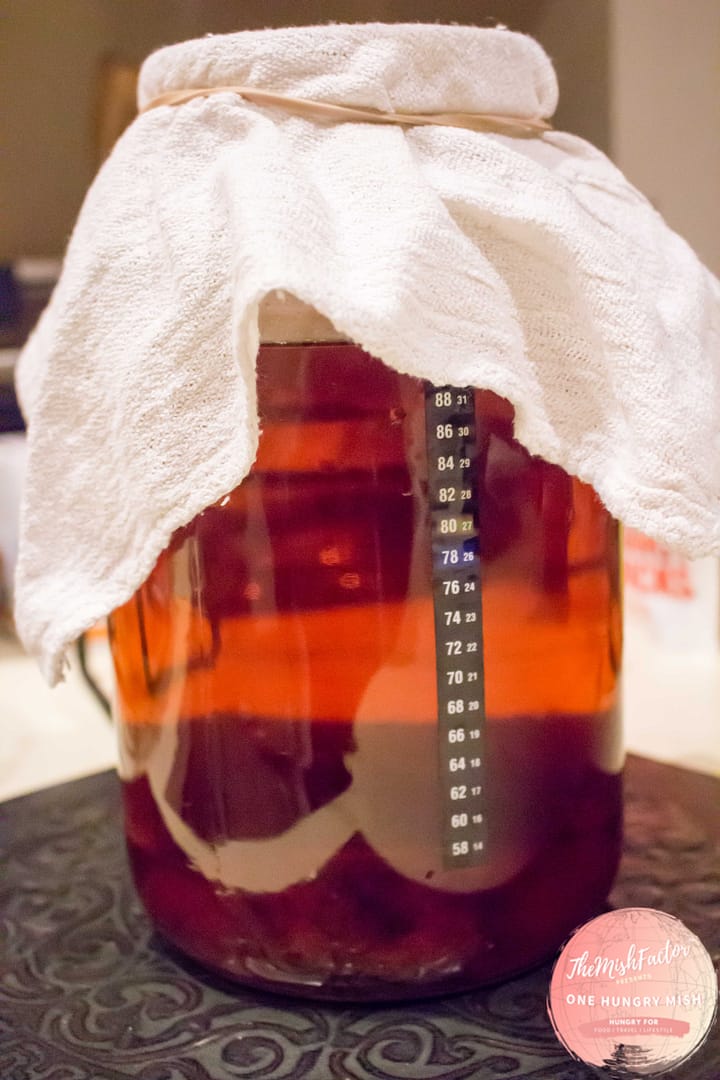If you know me, you’ve probably seen/heard/sensed my oncoming work on two-step fermentation. As a true food nerd and enthusiast for exploring curiosities, fermentation has always interested me. I’ve dabbled in pickling and (been deemed too carefree for) sourdough starters–I’m sure many people recall the great yeast shortage of 2020. I’ve read and reread bits and bobs of my Noma fermentation book for the blend of science and culinary marvel (there’s a reason it’s on my 5 Must Read Book List). Heck, I would have taken a food engineering class if I wasn’t so eager to graduate and start my career after my year long co-ops in the food and pet food industry (my degree still means I did in fact learn how to distill various fluids for science).
And as this blog is meant to capture these whimsies, I figured why not share what I’ve learned on getting started in kombucha making from the various sources in my network.
(Click here to jump to general tips and recipe!)
Also…to hold myself accountable–the goal for kombucha would be to make enough to have scoby specialized in black tea, green tea, and coffee (+ savory vegetables if I’m lucky enough to be like Noma one day!). Some liquids impart a permanent flavor to the ongoing brews as the SCOBY cultures acclimate to their environments, so it is best to leave them to their own devices.
What is Kombucha?
While it seems Kombucha has hit a bout of recent popularity, this is truly an ancient drink. Thought to have existed in ancient times, originating in China before spreading to Japan, and with more ancient findings of it being popularized in Eastern Europe and Russia–it’s safe to say kombucha is a timeless classic. Combining black tea and sugar (or if making Jun, another ancient drink similar to kombucha utilizing green tea and raw honey) in a secure, warm and aerated area allows for the fermentation to begin to create this drink. While modern uses heavily rely on a thick, gelatinous looking SCOBY (symbiotic culture of bacteria and yeast)–SCOBY technically is just the equivalent of a NYC borough full of the same bacteria and yeast found in the local environment floating about.
The SCOBY converts sugar to ethanol and then converts ethanol to acetic acid, all in a continuous process, yielding a three way balance of sugars, acids, and sugar alcohols to suspended in a flavor matrix of tea and any add-ins in the final ferment process.
Ferments…There’s more than one?
So in kombucha and jun fermentation a lot of people who brew consider it a two phase fermentation. There’s the initial phase (which I am in now) that can take 1 week to 1 month to occur (timing depends on environment, if you have an established SCOBY and flavor preferences). During that phase the tea becomes more acidic as the SCOBY does it’s thing. After one week you’re supposed to taste it and if it tastes good to you (the subjective right balance of sweet and sour) it’s time to move onto the second fermentation phase. If not, let it do it’s thing. You do want to check daily as it can proliferate on converting sugars all the way through acetic acid leaving you with some labor of love vinegar. (For those slightly more food science oriented, SCOBY is composed of yeast and bacteria that yield yeast, LAB, and AAB fermentation processes.)
Once it’s ready to move onto phase two, you remove the SCOBY (putting it in a SCOBY hotel or starting another batch!) and bottle the brews, adding in extra sugar and/or flavors to give it that special zing. This is the tricky stage since this also is the stage where things carbonate from fermenting–which while delicious have people paranoid of what they call “booch bombs” from over pressurizing. Fear not, r/kombucha covers a lot of 101 concerns, and to be frank Noma’s book was pretty blase about it.
General Tips
- Sanitize, sanitize, sanitize. It’s the golden rule of fermenting. Both to kill off unwanted bacteria (since the conditions to ferment kombucha is great for more than just the SCOBY) and prevent accidentally off balancing the SCOBY and fight with SCOBY for resources
- Use teas that do not have oil additives (RIP earl gray) as oil can inhibit the process
- The environment you ferment in matters–SCOBY thrives in 65-85F range, at optimal range at 70+, <65 F is risky for mold to overtake the beverage (do not consume some molds release water soluble toxins) >85F create other issues
- To ferment in the winter if you live somewhere cold, consider putting your container near a heating source and insulating with blankets or buying a seedling heating pad for it
- Avoid putting your brew in direct sunlight–UV rays kill yeast, and UV rays come from the sun
- Once you find a place for the ferment, don’t move it, jostling the goods can disrupt the process especially if you’re starting your brew from Day 0/scratch
- Avoid solid flavor add ins in the second ferment if possible, it creates a prime vector for mass carbonation, which sounds great until your bottle bursts and you have a mess to clean up instead of kombucha to enjoy
- If your physical puck of a SCOBY (technically a pellicle but I digress) is getting big you can cut it and give away the cuttings to others interested in kombucha or use them to experiment with more niche brews!
- Kombucha can get down to ~2.5pH so you want to avoid plastic and metals as a quick rule of thumb unless you know it’s protected against scratching/corrosion.
As again, I am learning this from my Noma book, and from the reddit crew, I used:
—
- 2 TBSP loose leaf English Breakfast
- 1 gallon glass jar
- 1 butter muslin + rubber band
- 12 cups of distilled water
- 1 cup of white sugar
- 1 cup of shite vinegar (tweak as needed, needs to be ≤4.5pH)
- 1 very dry SCOBY
- pH strips to gauge acidity
Shortcut to the master recipe I followed from the reddit crew is located here.
Stay Hungry
XOXO
Mish ♥

